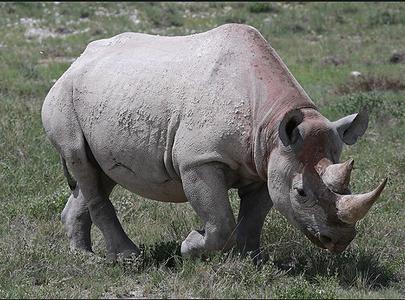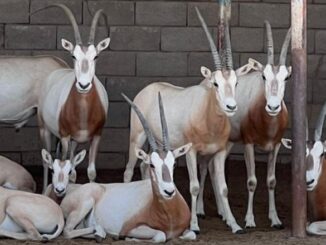
DURHAM, North Carolina, September 14, 2020 (ENS) – Interactive software that reads and analyzes footprints left by black rhinoceroses can be used to monitor the movements of the critically endangered animals in the wild, giving conservationists a new way to keep watch on the species and help keep them safe from poachers, according to a new Duke University-led study.
The software called the Footprint Identification Technique, or FIT, runs on JMP software from SAS Institute. JMP is a suite of computer programs for statistical analysis developed by the JMP business unit of the SAS Institute, an American multinational developer of analytics software based in Cary, North Carolina.

The software uses advanced algorithms to analyze more than 100 measurements of a rhino’s footprint.
Because each rhino’s footprint is as distinctive as a human fingerprint, the analyzed images can be archived electronically in a global database of previously collected footprint images for matching.
“If you find a match, you can identify the individual animal who left the mark and, by plotting the locations of all the other places that mark has been seen, track its movements without disturbing it or coming into close enough contact with it for there to be a risk of animal-to-human viral transmissions,” said Zoe Jewell, adjunct associate professor at Duke University’s Nicholas School of the Environment.
Jewell is also a principal research associate at the JMP Division of the SAS Institute. She co-led the study and is co-creator of the Footprint Identification Technique.
“It’s a cost-effective approach that not only protects the health of the rhino and the human but also brings a centuries-old tracking skill into the 21st Century,” she said.
Jewell and her colleagues are now working with Namibia’s Ministry of Environment, Forestry and Tourism to train wildlife conservationists, land managers, local guides and anti-poaching agents how to use FIT.
The scientists published their peer-reviewed study describing the technology’s effectiveness for monitoring the endangered rhinos on August 14 in the open-access journal “PeerJ.”
Namibia is home to an estimated 2,000 black rhinos or about 90 percent of the species’ total population worldwide. Though legally owned by the government, the animals are dispersed geographically on private lands across the country.
The black rhinos of Namibia are unique, thriving even in a harsh, desert-like landscape, explain staff members at Namibia’s Etosha National Park. They have evolved to survive without water for several days and have even developed a resistance to the toxic chemicals in the plants that they depend on for survival during long droughts. They also have much bigger ranges than other species of black rhino.
Stepped up government policing in recent years has slowed the rate of loss due to poaching, but between 30 and 50 rhinos are still slain each year for their horns.
Rhino horns, made of keratin like human hair and fingernails, have no medicinal powers but they can sell for more than US$60,000 a kilogram on the Asian black market, where they are used in traditional medicine or displayed as a symbol of wealth and success.
“You essentially have these animals with horns worth $100,000 or more that disappear from sight into the Namibian backcountry, making them an almost irresistible target for poachers. Authorities often don’t know a missing rhino has been poached until they find its bones or carcass,” said Jewell.
FIT allows the animals to be monitored three different ways, allowing scientists, managers, guides or anti-poaching patrols to use the software as best meets their individual needs and constraints, she said.
In the simplest option, the heel pattern on a digital image of the footprint is compared to images already in the FIT database to search for a match. This use is well-suited to situations where a random footprint is found in the wild.

The FIT software can also do a survey of footprints throughout the protected area and take measurements from each print to estimate the number of rhinos in that area. This can be useful information for calculating resource needs, the number of patrol vehicles, for instance, to monitor the animals effectively.
In the most advanced option, each individual rhino can be tracked and matched to its unique footprint using both FIT and heel-patterns. This creates an interactive library that anti-poaching patrols can use to search for animals at the highest risk, including those known to frequent areas under threat from poachers or those whose footprints haven’t been showing up in recent years.
“FIT is a distillation of the traditional ecological skills of the expert trackers who have lived and worked within Africa for many years,” said Sky Alibhai, also an adjunct associate professor at Duke’s Nicholas School and principal research associate at the JMP Division of SAS.
Alibhai is a veterinarian and wildlife biologist who worked for many years in Africa monitoring black and white rhino. He co-led the study and co-developed the FIT technology with Jewell. He says using FIT can benefit whole communities by allowing their skills to be used effectively in conservation.”
Jewell and Alibhai co-founded and now lead a nonprofit organization called WildTrack that promotes the use of FIT and other noninvasive, community-inclusive monitoring techniques worldwide, including artificial intelligence. The organization currently has more than 20 projects worldwide, including work to protect Bengal tigers in India, giant pandas in China, and mountain lions in the Americas.
Co-authors on the new study were Peter Law of the African Centre for Conservation Ecology at Nelson Mandela University; Kenneth Uiseb of the Namibian Ministry of Environment, Forestry and Tourism; and Stephen Lee of the U.S. Army Research Office.
CITATION: “Monitoring Rhinoceroses in Namibia’s Private Custodianship Properties,” Zoe C. Jewell, Sky Alibhai, Peter R. Law, Kenneth Uiseb and Stephen Lee. PeerJ, Aug. 14, 2020. DOI: https://doi.org/10.7717/peerj.9670
Copyright Environment News Service (ENS) 2020. All rights reserved.
© 2020, Environment News Service. All rights reserved. Content may be quoted only with proper attribution and a direct link to the original article. Full reproduction is prohibited.



